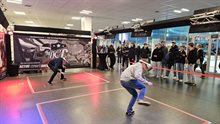The world of Virtual Reality and Sport
In the FNS partner interviews, we feature a partner every week. Our partners give insight into developments and innovations within their company and their role at 6G Future Network Services.
PWXR, led by CEO Peter Kortenhoeven, has taken ambitious steps to combine the future of virtual reality (VR) with functional movement. The company, born out of an earlier initiative, has transformed itself into a pioneer in motion capture that flawlessly translates real-life movement into the virtual world. Peter explains how he once started developing VR content that allowed users to walk around wirelessly, a technology that has now evolved into an intense, sports-oriented experience without physical sensor suits: "We are the first globally to enable movement and sports without such suits and now based on camera tracking."
Sport and VR
The heart of PWXR's technology lies in harnessing cameras to track body movement. This means users can see their entire body, from knees to elbows, moving in real time in the virtual world without having to wear heavy sensors. "When someone suggested to us that this could become the new sports, at first I thought it was a joke," Peter explains, "but gradually we saw that this technology actually got people moving."
Step by step towards 6G
For PWXR, the speed and reliability of the data connection is crucial. While the current system still uses local network without 5G, PWXR is looking ahead to the possibilities of 6G.
PWXR will experiment with 5G in the short term to see how the technology performs when the data connection is extended beyond a local area. The system will be tested for reliability and speed to determine whether it is possible for users in different locations to play against each other without delay.
Steps can then be taken for the ultimate test, for adopting 6G technology. "With 6G, we hope to eventually operate without local equipment, allowing users to be connected globally," Peter says enthusiastically. "This would mean that the current setup, which still requires relatively on-site large servers and gaming systems, could be replaced by cloud-based technologies."
This perspective not only offers advantages in scalability, but also makes the system more accessible and affordable to a wider audience.
The NXT Fit at the Haagse Sport Centrale: launch January 2025
The plans for a physical location, The NXT Fit in The Hague, represent an important step in PWXR's growth path. This center will be an incubator for innovation, helping users move and discover technology in a playful way. The aim is to create a hub here where sport, technology and social impact go hand in hand. This center in The Hague will also serve as a meeting place for companies, schools and institutions that want to contribute to a healthier and sportier society, and where they can discover new technologies that stimulate movement and vitality in a playful way. Peter explains: "We want to inspire people and make the line between fitness and fun disappear. So companies can use it for vitality days and schools can organise sports competitions."
Peter shares that there are even plans for school competitions, in which young people are not only gaming, but also activated to take up sports. Previous tests showed that 25% of young people, who did not normally play sports, took trial lessons in sports clubs after participating in the competition. "We are trying to use technology to become a conduit to grassroots sport," Peter explains.

A wide range of applications
The possibilities of PWXR's technology go beyond sports and leisure activities. The system can also be used for physiotherapy, preventive healthcare and training. Indeed, the technology has the potential to disable and play back complex movement patterns, which can be particularly useful for rehabilitation exercises or customised fitness programs, for example. "Think of simulated workouts that encourage people to live healthier lives. The applications are endless when you can monitor and improve the whole body," Peter says excitedly.
Challenges
Although PWXR has made great strides, there are also challenges. One of the biggest obstacles is building a solid community that continues to use the technology for a long time. Peter points out that retaining users is a challenge: "We want people to repeat, for example through an app where you can see scores and replays. Building that community is essential to our success." Another goal is to make the system as compact as possible, so that it eventually works with just VR glasses and a phone.
Future
The road to 2030 is ambitious, but the vision is clear: PWXR's technology should eventually become accessible to everyone, in the gym, in recreation rooms or even at home. Peter's vision involves not only growing the company, but also contributing to social causes. He concludes hopefully: "Our success will depend not only on our technology, but also on the people who support us along the way, such as partners and investors. The center in The Hague is just the beginning, the technology will open the doors to applications in gyms, sports centers and even at home, where then a simple set-up will suffice to log in and get started right away. I look forward to this step that makes exercise technology available to everyone."
Want to know more or collaborate with PWXR? Email: info@pwxr.world
